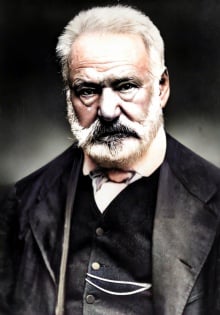Overview
Victor Hugo’s Ninety-Three (1874) is a dramatic portrait of the French Revolution at its most convulsive moment, set in 1793 during the Vendée and Breton insurrections and the Parisian Terror. It intertwines three emblematic figures, an implacable royalist grandee, a generous young republican commander, and a ferocious Jacobin commissar, to explore the collision between justice and mercy, law and conscience, ideology and humanity.
Setting and Context
The novel moves between the Atlantic coast and the forests and strongholds of Brittany, where royalist Chouans launch a guerrilla war against the nascent Republic. In Paris, the Committee of Public Safety radiates its doctrine of iron necessity. Hugo stages history as both vast tempest and intimate moral crucible, with storms at sea, sieges, and tribunals mirroring the inner tempests of those who must decide between principle and pity.
Plot Summary
The book opens aboard a Republican warship in a gale, when a cannon breaks loose and ravages the hold. The crew subdues the “loose cannon,” but the negligent gunner is summarily executed, a chilling emblem of revolutionary discipline. Under cover of this chaos, the Marquis de Lantenac, an aristocrat and master strategist, lands in Brittany to ignite royalist resistance aided by loyalists like the sailor Halmalo.
Across the countryside wanders Michelle Fléchard, a widowed peasant woman, searching for her three children, René-Jean, Gros-Alain, and Georgette, after a massacre scatters her family. The children fall into Lantenac’s hands and become hostages, tokens in a war where innocence is currency. The Republic’s forces, commanded by the idealistic Gauvain and overseen by Cimourdain, a former priest turned uncompromising delegate of the Convention, close in on Lantenac’s redoubt, the feudal tower of La Tourgue.
Gauvain, a noble by birth and revolutionary by conviction, espouses clemency and a future founded on liberty tempered by compassion. Cimourdain, who educated him and loves him with austere intensity, embodies the Revolution’s pitiless logic: to spare is to betray. Their mutual devotion collides with irreconcilable codes as the siege tightens and small acts of kindness risk strategic catastrophe.
Climax and Resolution
The siege culminates in an inferno at La Tourgue. Amid smoke and collapsing masonry, Lantenac performs the novel’s most searing act: he turns back from escape to rescue the three trapped children, carrying them through fire to safety. His chivalric courage exposes the paradox of the old order, cruel in cause yet capable of magnanimity. Captured, he faces certain death.
Gauvain, moved by the rescue and loyal to his own creed of humanity, secretly frees Lantenac and accepts responsibility for the act. Cimourdain convenes a tribunal and, with iron fairness, condemns his beloved pupil for treason to the Republic. On the scaffold Gauvain articulates a vision beyond the Terror, of a society without feudal privilege or vengeance, where law serves mercy and war yields to peace. As the blade falls, Cimourdain, having sacrificed love to duty, turns his pistol upon himself, sealing the tragedy with a final, terrible equilibrium.
Themes and Symbolism
Hugo arrays his symbols with stark clarity. The loose cannon dramatizes revolutionary force unmoored from control; La Tourgue embodies the crumbling yet stubborn fortress of the ancien régime; the three children stand for France’s future, passed between factions and saved only by individual courage. Through Lantenac, Gauvain, and Cimourdain, the novel triangulates aristocratic honor, humanitarian idealism, and doctrinaire severity, refusing caricature and insisting on the moral complexity of all sides.
Significance
Ninety-Three distills Hugo’s lifelong meditation on political violence and moral choice. It acknowledges the Revolution’s necessity while indicting its fanaticism, honors personal heroism on both sides, and locates true nobility in acts of mercy. The final exchange, life for life, conviction against compassion, leaves a stark, enduring question: by what law should a nation, and a soul, be governed when history itself is a storm.
Ninety-Three
Original Title: Quatrevingt-treize
Ninety-Three is set during the French Revolution and focuses on the theme of human justice vs. divine justice. It tells the story of a nobleman who leads a group of royalist insurgents against the Republic, only to find himself hunted by both his former friends and his enemies as the tide of revolution shifts.
Author: Victor Hugo
 Victor Hugo, the influential French author and politician known for classic literature like 'Les Miserables' and 'The Hunchback of Notre-Dame'.
Victor Hugo, the influential French author and politician known for classic literature like 'Les Miserables' and 'The Hunchback of Notre-Dame'.
More about Victor Hugo
 Victor Hugo, the influential French author and politician known for classic literature like 'Les Miserables' and 'The Hunchback of Notre-Dame'.
Victor Hugo, the influential French author and politician known for classic literature like 'Les Miserables' and 'The Hunchback of Notre-Dame'.